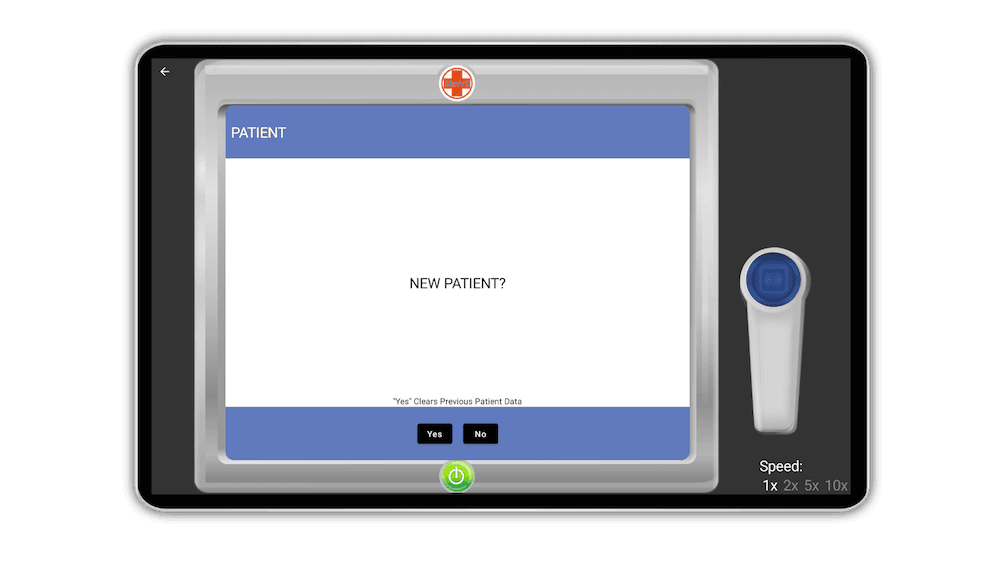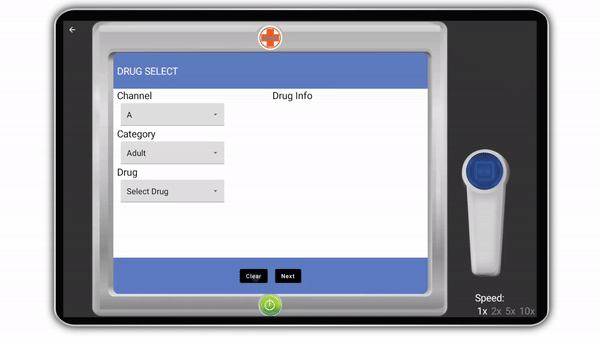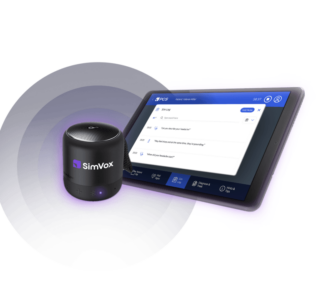NEW Simulated PCA Pump from SimVS
SimVS is proud to announce the addition of a Patient Controlled Analgesia (PCA) pump simulator to the recently developed SimVS-IV infusion pump simulator. The simulated PCA pump module is ready for healthcare simulation educators to teach their students best practices. PCA pumps allow patients to manage their pain by self-administering small doses of intravenous analgesia within set limits and are an important high-stakes technology for patient care in many settings. The potential for complications from opioid PCA pump administration makes this an essential skill for healthcare providers. By allowing for numerous practice attempts in a psychologically safe environment SimVS-IV and the PCA module allow students to develop the necessary familiarity and confidence to be prepared to operate independently in future care settings. This HealthySimulation.com article will discuss the practical application of the PCA pump in healthcare simulation.
Healthcare simulation provides an ideal setting to allow practice and development of competence for PCA pump management. When PCA mastery is the primary focus, the learning objectives should focus on safe medication administration and safe operation of a PCA. Since many institutions will not allow students to set up or operate PCAs, setup and operation of the PCA may be challenging for new healthcare practitioners or undergraduate students.
Sponsored Content:
A Critical Intervention & Overview of PCA Pumps
A systematic literature review of postoperative patients demonstrated an incidence ranging from 0.04% when naloxone use was the outcome of interest, up to 41% if assessed by the presence of hypoxemia or bradypnea. These potential complications from opioid PCA pump administration make this an essential skill for healthcare providers. This HealthySimulation.com discusses the PCA pain management pump and how the SimVS PCA pump can be used in medical simulation.
View the LEARN CE/CME Platform Webinar Revolutionize Medication Training with SimVS-IV, the World’s First Infusion Pump Simulator to learn more!
Research has shown that when patients keep their pain within tolerable levels and receive regular small doses of pain medication, the total amount needed to keep the patient comfortable is less than when larger doses of pain medication are given further apart. The PCA mode of therapy minimizes the roller-coaster effects of peaks of sedation and valleys of pain that occur with the traditional method of PRN dosing.
Sponsored Content:
SimVS IV Pump Simulator PCA Module
This module allows for:
- Creating relevant profiles in the drug library
- Sending medication orders to student tablets
- Operation of standard PCA features, such as setting the loading, continuous, and bolus doses
- Functional patient request button
- Two-way monitoring of student decisions.
Practical Suggestions for PCA Pump Simulation Scenarios
- Set up new PCA, including correct interpretation of written orders with patient and family teaching
- Provide records that show the patient has or has not been using the PCA
- Have a patient with low RR or difficult to arouse
- Have patient on PCA, low RR, increased sedation, and requires Naloxone administration
- Repeat Naloxone administration due to the difference in half-life of opioid and Naloxone
- Have a family member press the PCA button
- Have PCA set-up but with the wrong medication
- Have PCA set up with the wrong settings
- Have PCA set- up with expired tubing
Background Information to Incorporate into the PCA Pump Simulation Scenario
A HealthySimulation.com PCA article written by Dr. Kim Baily, MSN, PhD, RN, CNE, provides more in-depth information on the PCA pump, including background information and evidence-based practice to include in a healthcare simulation scenario.
- MD order should contain the following information, which is programmed into the PCA pump:
- Morphine and Hydromorphone are the two most common analgesics used in PCA pumps
- Loading Dose (initial bolus)
- Continuous infusion (basal infusion)
- PCA dose:
- Dose received when patient presses button is 2mg.
- Dose interval – time between doses e.g. 6, 8, or 10 minutes.
- No matter how frequently a patient pushes the button, they will only receive one dose within the preset dose interval.
- Maximum limit (Lockout interval) in one hour. This includes continuous dose and PCA dose.
- Normal saline at around 30 ml /hr to run continuously with the PCA may be used if no other IV fluid is prescribed.
- The most serious side effects include suppression of respiratory rate and sedation. Therefore, vital signs, pain level, and sedation level are routinely monitored.
- Patients and families must be educated about the use of PCA. Families should not press the button for patients.
- Patients must be alert enough and physically capable of pressing the button at the appropriate interval.
- Poor mobility or confusion are contraindications for PCA use.
- Dosing for opiate-naive patients and patients with opioid tolerance will be different.
- The number of times a patient requests pain medication is recorded on the infusion pump. This number may indicate the level of pain control achieved.
- Common side effects of opioid use include:
- Respiratory depression, sedation, constipation, nausea and vomiting, and itching.
- The most serious of adverse reactions is opioid-induced ventilatory impairment (OIVI).
- Risk factors for OIVI include: Obesity, history of snoring or witnessed apneas, preexisting pulmonary or cardiac disease or dysfunction, smoker.
- The American Society of Anesthesiologists patient considers the following as additional risks for OIVI:
- Concomitant administration of sedating agents, such as benzodiazepines or antihistamines.
- Continuous opioid infusion in opioid-naïve patients first 24 hours of opioid therapy.
- Thoracic and other large incisions that may interfere with adequate ventilation.
- Large single bolus techniques
- Naloxone administration: Patients given naloxone are at higher risk for additional episodes of respiratory depression.
- STOP-BANG mnemonic to identify patients at risk.
- Snoring—Do you snore loudly?
- Tired—Do you often have daytime tiredness, fatigue, or sleepiness?
- Observed—Has anyone seen you stop breathing while you sleep?
- Blood Pressure—Do you have or are you being treated for high blood pressure?
- BMI >35 kg/m2?
- Age >50 years?
- Neck Circumference >40 cm
- Gender—Male?
Teaching Safety Concerns with PCA Pump and SimVS Monitors to Improve Patient Care
SimVS Diagnostic Essentials provides the base for learners to obtain objective data to begin the development of the patient’s plan of care. The SimVS Diagnostic Essentials comes with the ability to obtain baseline and periodic patient information that includes blood pressure, heart rate, respiratory rate, pulse oximeter, and thermometer.
This allows the learner to observe trends and use critical thinking to analyze the data. SimVS will release an ETCO2 monitor in 2024. Monitoring the EtCO2 and effective respiratory rate improves clinicians’ confidence to assess the efficacy and patient’s response to the opioid dose for effective pain management without excessive respiratory depression for patients.
SimVS developed the world’s first virtual IV Pump in 2023. In April 2023 SimVS set forth to assist faculty members to instill safe medication delivery practices for their learners. This cutting-edge technology provides users with a realistic and safe environment to practice the administration of IV medications and fluids. The virtual IV pump offers a cost-effective and risk-free alternative to traditional training equipment, just like the virtual monitors and defibrillators range offered by SimVS.
One advantage the SimVS pump offers the learners is the capability to practice psychomotor skills and critical thinking to learn a complex skill. The SimVS IV-Pump comes with four commonly seen pump interfaces to meet the requirements of any medical simulation center, regardless of which IV interface the student may encounter in real life. The SimVS IV-Pump can incorporate volume, dose, and weight-based calculations, primary and secondary infusions, dosage controls, and drug selections. The learners can navigate drug selection and dosage controls along with primary and secondary infusions.
More About SimVS
Today, SimVS is one of the world’s most successful providers of simulated medical device monitors, boasting thousands of unit installations on devices across the globe. The founders of SimVS recognized that existing healthcare simulation equipment was both expensive and cumbersome, so an effort was made to create more accessible alternatives that would enhance the clinical training experience. SimVS accomplished this by creating a product line of simulated patient virtual monitors, defibrillators, vital sign devices, call bells, ventilators, and more. SimVS has emerged as a trailblazer in the development of affordable simulated medical device technology to enhance the realism of the experiential learning environment.
Learn More About SimVS and the PCA Pump!
Reference
- Frederickson, T. W., & Lambrecht, J. E. (2018). Using the 2018 guidelines from the joint commission to kickstart your hospital’s program to reduce opioid-induced ventilatory impairment. APSF Newsletter, 33(1), 1-8.
Teresa Gore, PhD, DNP, APRN, FNP-BC, CHSE-A, FSSH, FAAN – Dr. Gore has experience in educating future nurses in the undergraduate and graduate nursing programs. Dr. Gore has a PhD in Adult Education, a DNP as a family nurse practitioner, and a certificate in Simulation Education. Dr. Gore is an innovative, compassionate educator and an expert in the field of healthcare simulation. In 2007l Teresa started her journey in healthcare simulation. She is involved in INACSL and SSH. She is a Past-President of INACSL and is a Certified Healthcare Simulation Educator Advanced (CHSE-A). In 2018, she was inducted as a Fellow in the American Academy of Nursing (FAAN). In 2021, she was inducted as a Fellow in the Society of Simulation in Healthcare Academy (FSSH) and selected as a Visionary Leader University of Alabama at Birmingham School of Nursing Alumni. During her career, Dr. Gore has led in the development and integration of simulation into all undergraduate clinical courses and started an OSCE program for APRN students. Her research interests and scholarly work focus on simulation, online course development and faculty development. She has numerous invited presentations nationally and internationally on simulation topics.
Sponsored Content:




















